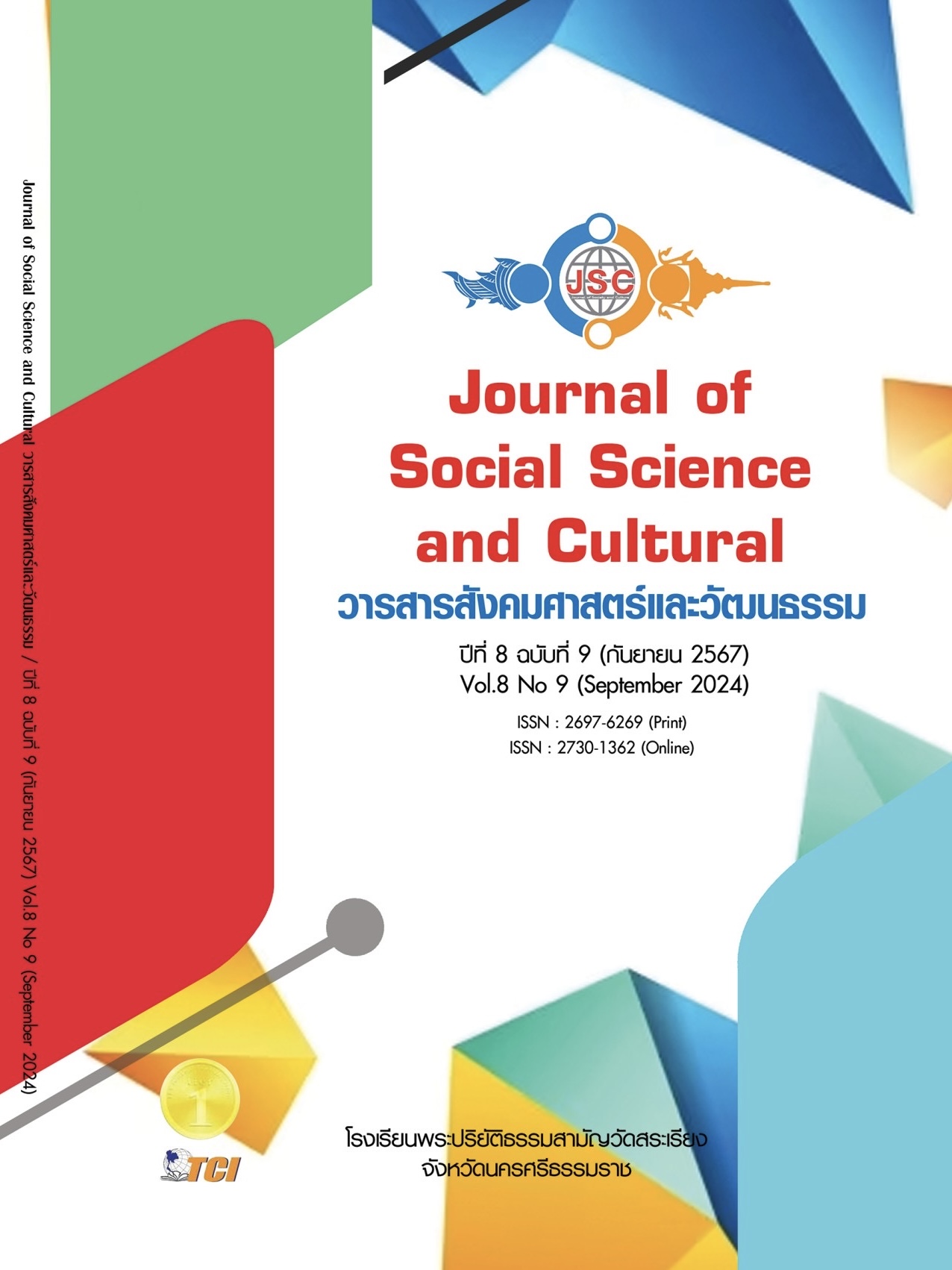SUSTAINABLE INNOVATIONS IN RUBBER PLANTATION MANAGEMENT
Main Article Content
Abstract
This research aims to 1) identify the challenges and obstacles faced by rubber plantations, 2) explore sustainable management practices for rubber plantations in economic, social, and environmental dimensions, and 3) propose innovative models for sustainable rubber plantation management across these dimensions. This qualitative study involved 22 key informants, selected purposively, who are experts in sustainable rubber plantation management. The informants include 6 government officials, 8 large-scale rubber plantation owners (with more than 19 rai per district), and 8 small-scale rubber plantation owners (with less than 19 rai per district). Data were collected through in-depth interviews using structured interview guidelines to assess performance, analyze issues, and develop innovative sustainable management practices. The findings reveal that rubber plantations face several significant challenges, including 1) price volatility, 2) insufficient government policies regarding rubber prices, and 3) low market prices. Additionally, most plantation owners have not yet adopted modern technologies such as drip irrigation systems and IoT technology, which are crucial for increasing productivity, reducing costs, and achieving sustainability in rubber plantations.
Article Details
References
ผู้ให้ข้อมูลคนที่ 11. (21 ก.พ. 2567). ปัญหา และอุปสรรคในการจัดการสวนยางพารา. (ยงยุทธ แก้วน้อย, ผู้สัมภาษณ์)
ผู้ให้ข้อมูลคนที่ 12. (12 ก.พ. 2567). ปัญหา และอุปสรรคในการจัดการสวนยางพารา. (ยงยุทธ แก้วน้อย, ผู้สัมภาษณ์)
ผู้ให้ข้อมูลคนที่ 13. (23 ก.พ. 2567). วิธีการจัดการสวนยางพาราอย่างยั่งยืนในด้านเศรษฐกิจ สังคม และสิ่งแวดล้อม. (ยงยุทธ แก้วน้อย, ผู้สัมภาษณ์)
ผู้ให้ข้อมูลคนที่ 14. (23 ก.พ. 2567). วิธีการจัดการสวนยางพาราอย่างยั่งยืนในด้านเศรษฐกิจ สังคม และสิ่งแวดล้อม. (ยงยุทธ แก้วน้อย, ผู้สัมภาษณ์)
ผู้ให้ข้อมูลคนที่ 15. (21 ก.พ. 2567). วิธีการจัดการสวนยางพาราอย่างยั่งยืนในด้านเศรษฐกิจ สังคม และสิ่งแวดล้อม. (ยงยุทธ แก้วน้อย, ผู้สัมภาษณ์)
ผู้ให้ข้อมูลคนที่ 17. (11 ก.พ. 2567). วิธีการจัดการสวนยางพาราอย่างยั่งยืนในด้านเศรษฐกิจ สังคม และสิ่งแวดล้อม. (ยงยุทธ แก้วน้อย, ผู้สัมภาษณ์)
ผู้ให้ข้อมูลคนที่ 18. (15 ก.พ. 2567). วิธีการจัดการสวนยางพาราอย่างยั่งยืนในด้านเศรษฐกิจ สังคม และสิ่งแวดล้อม. (ยงยุทธ แก้วน้อย, ผู้สัมภาษณ์)
ผู้ให้ข้อมูลคนที่ 19. (15 ก.พ. 2567). วิธีการจัดการสวนยางพาราอย่างยั่งยืนในด้านเศรษฐกิจ สังคม และสิ่งแวดล้อม. (ยงยุทธ แก้วน้อย, ผู้สัมภาษณ์)
ผู้ให้ข้อมูลคนที่ 7. (12 ก.พ. 2567). ปัญหา และอุปสรรคในการจัดการสวนยางพารา. (ยงยุทธ แก้วน้อย, ผู้สัมภาษณ์)
ผู้ให้ข้อมูลคนที่ 8. (12 ก.พ. 2567). ปัญหา และอุปสรรคในการจัดการสวนยางพารา. (ยงยุทธ แก้วน้อย, ผู้สัมภาษณ์)
ผู้ให้ข้อมูลคนที่ 9. (10 ก.พ. 2567). ปัญหา และอุปสรรคในการจัดการสวนยางพารา. (ยงยุทธ แก้วน้อย, ผู้สัมภาษณ์)
Ahmad, S. N. S. et al. (2016). Evaluation of labor costof rubber tapping activity for smallholder rubber plantations in Malaysia. Journal of Tropical Agriculture and Food Science, 12(18), 93-104.
Azman, N. A. A. & Jaafar, A. S. (2019). Rubber tree breeding for disease resistance: Current status and future prospects. Malaysian Journal of Rubber Research, 22(3), 305-321.
Balamurugan, M. et al. (2012). Effect of biofertilizers on growth and yield of rubber (Hevea Brasiliense’s) in Malaysia. Journal of Rubber Research, 26(2),111-123.
Harshani, K. A. P. & Shantha, A. A. (2021). Factors Affecting the Economic Efficiency of Small-Scale Rubber Plantations: With Special Reference to Kalutara District in Sri Lanka. Colombo Business Journal International Journal of Theory and Practice, 12(1),145-156.
Indianite, R. & Richman, A. (2017). Challenges in accessing finance for smallholder rubber farmers. Journal of Small Business Finance, 7(4), 154-171.
Kanchana, S. et al. (2021). IoT in agriculture: Revolutionizing water management in rubber plantations. Journal of Smart Farming Technologies, 9(1), 45-57.
Kusuma, A. & Wahidin, T. (2018). Access to agricultural finance in rural areas: The role of cooperatives and microfinance institutions. Journal of Rural Finance, 15(1), 104-121.
Moreira, V. P. et al. (2017). Intercropping practices in rubber plantations: Economic benefits and ecological implications. International Journal of Agroforestry, 23(3), 289-299.
Rahman, M. M. et al. (2018). The role of IoT and drip irrigation in enhancing rubber production: A review. International Journal of Agricultural Technology, 14(2), 327-341.
Songsmith, S. & Postnasal, N. (2014). Rubber sheet and block production: Techniques and challenges. Journal of Industrial Rubber Products, 12(4), 87-102.
Tanthapanichakoon, W. et al. (2018). Labor shortages in the Thai rubber industry: Challenges and solutions. Asian Journal of Agriculture and Rural Development, 8(2), 243-256.
Taweesin, K. et al. (2020). Water management practices in rubber plantations: Effects on yield and sustainability. Rubber Science, 33(1), 85-98.
Yaacob, M. R. et al. (2015). The economic impact of rubber price volatility on smallholders in Malaysia. Journal of Agricultural Economics, 66(2), 457-476.


